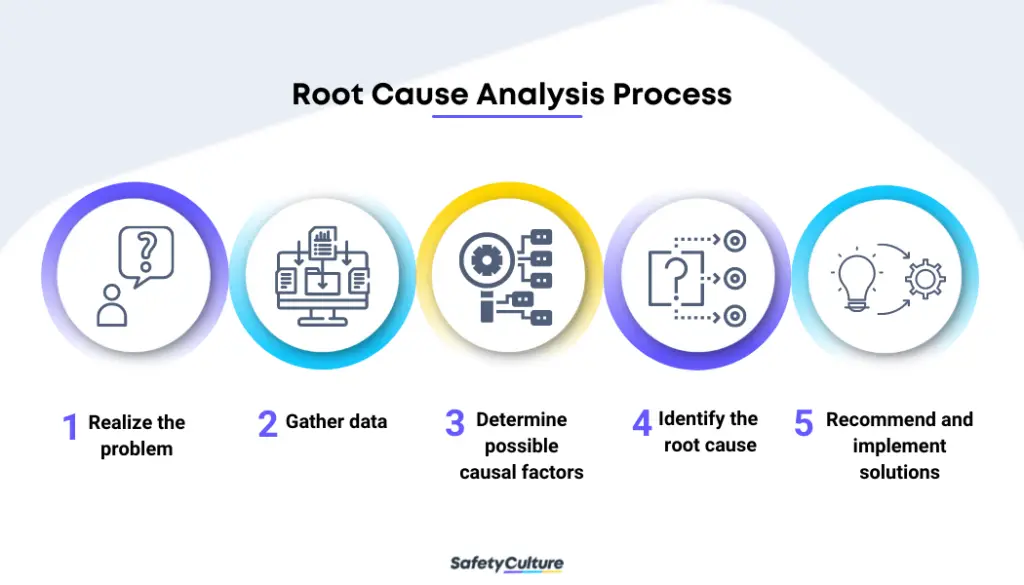What is Root Cause Analysis (RCA)?
The root cause analysis definition revolves around the process of identifying the source of a problem and looking for a solution in a way that the problem is treated at the root level. This way, organizations and professionals can look beyond the symptoms of the problem and work on where the real cause exists.
Importance
RCAs aim to gauge the challenges an organization should address to streamline its processes and achieve its goals. Hence, identifying the root causes of a problem helps in developing more effective strategies to overcome it.
Conducting a root cause analysis and implementing apt solutions help employers to significantly or completely prevent the same or similar issues and incidents from recurring. In this way, employers will help reduce the risk of death and/or injury to workers, the community, or environmental damage. Further, organizations can also avoid unnecessary costs due to business interruption, increased regulation, audits, and emergency response to name a few.
It’s also worth noting that when employers value prevention more than merely treating surface-level symptoms, public trust can be earned. Having an incident-free record may be more likely to attract and retain high-performing employees, further promoting a culture of safety.
History
Tracing back to the broader field of Total Quality Management (TQM), root cause analysis is part of a more general problem-solving process, and essentially plays an integral role in continuous improvement efforts. This methodology was developed by manufacturers in the 1950s with the goal to better understand industrial events.
3 Basic Types of Root Causes
There are 3 basic types of root causes that can have a potential impact on a problem, such as:
- Physical causes: May arise due to problems with any physical component of a system, such as hardware failure and equipment malfunction
- Human causes: May occur due to human error, caused by lack of skills and knowledge to perform a task
- Organizational causes: May happen when organizations use a system or process that is faulty or insufficient, in situations like giving incomplete instructions, making wrong decisions, and mishandling staff and property
RCA Categories
Root cause analysis is not a one-size-fits-all methodology. In fact, there are many various tools, processes, and techniques used in conducting it.
According to the National Association of State Mental Health Program Directors, most of the principles of RCA are classified into 5 major categories:
- Safety-based RCA: This process is used to examine and identify the root causes of any failure of safety observance, accident analysis, or other issues related to occupational safety and health.
- Production-based RCA: This is often conducted in the field of quality control for manufacturing to investigate the root causes of why certain defects are present either within the manufacturing process or end product.
- Process-based RCA: Serving as a follow-on to production-based RCA, this approach has been expanded to include business processes.
- Failure-based RCA: This is rooted in the concept of failure analysis, which is typically used in engineering and maintenance.
- Systems-based RCA: Combining two or more methods of RCA, this approach also takes ideas from fields such as change management, risk management, and systems analysis.
The Root Cause Analysis Process in 5 Simple Steps

Root Cause Analysis Process
As shown in the diagram above, the root cause analysis steps are:
- Realize the problem.
- Gather data.
- Determine possible causal factors.
- Identify the root cause.
- Recommend and implement solutions.
Going through each step in detail, here’s how you can perform root cause analysis.
Step 1: Realize the problem.
The first goal of RCA is to identify problems or defects, which is best done by simply asking: “What’s the problem?” By being able to define the problem, the symptoms, and the possible outcomes, you’ll be pointed to the right direction on how the analysis should go.
This step is also crucial in crafting a specific problem statement. Without it, it might be difficult to find and create the best recommendations and solutions. When writing a problem statement, make sure to keep these 3 things in mind:
- how you would describe the problem;
- what you see happening;
- what the specific symptoms are.
Step 2: Gather data.
Retrieve all relevant and available data about the incident. Collect and investigate the documentation files, initial issues found, preliminary actions taken, personnel or teams involved, and other key information that you think would be beneficial to identify the root cause.
Step 3: Determine possible causal factors.
A causal factor, as defined by the American Institute of Chemical Engineers, is a major unplanned contributor to a negative event or undesirable situation. If eliminated, causal factors would have either prevented the incident from happening or reduced its risks and frequency.
This is where the heart of your analysis enters the picture. Start this step by reconstructing a timeline of events in such a way that you’ll be able to pinpoint exactly what led to the problem and other issues that coexist with the one you’re dealing with. This method is crucial for you to realize specific causal factors.
Step 4: Identify the root cause.
This is where you choose which of the root cause analysis tools you should use to discover the root causes of each causal factor you’ll encounter. Refer to the next section for the 5 best ways on how to do root cause analysis.
Step 5: Recommend and implement solutions.
Upon identifying the root cause, you can now recommend preventive measures to ensure that the problem won’t happen again. Further, develop a comprehensive timeline and plan on how you can implement the solution in such a way that all of the stakeholders involved are well-informed and trained toward proactive quality management.
Create Your Own Root Cause Analysis Template
Eliminate manual tasks and streamline your operations.
Get started for FREE5 Best Ways on How to Do Root Cause Analysis (with Examples)
Ideally, a combination of various tools and techniques should be used to conduct root cause analysis in your organization. These tools are grouped under the following general categories:
- Brainstorming
- Checklists
- Logic/Event Trees
- Timelines
- Sequence Diagrams
- Causal Factor Determination
As you look for root cause analysis techniques and root cause analysis examples, start by exploring these most commonly used ones and see if these are appropriate for the situation you’re aiming to address.
The 5 Whys
This is considered the simplest approach to RCA. Basically, this method employs only one step, being repeated over and over again. All you need to do is start with a problem statement and then ask “Why?” 5 times, with each “Why?” leading you closer to the root cause.
What is an example of root cause analysis using The 5 Whys?
- Problem statement: The electric water heater suddenly stopped working.
- Why did it stop? It was found that the circuit breaker was tripped.
- Why did the circuit breaker trip? The electric water heater was about to overheat.
- Why was the electric water heater about to overheat? A buildup of sediment was found around the heating elements.
- Why was the machine not checked and cleaned? There was a missed inspection and maintenance routine.
- Why was there a missed routine check? The assigned team member wasn’t properly informed about the schedule.
Download a free 5 Whys template.
FMEA
As one of the most in-depth root cause analysis methods, the Failure Mode and Effects Analysis or FMEA process uses hypothetical “What if?” questions to prompt an understanding of the problem at hand. This is best applied to establish cause-and-effect relationships that aim to describe why specific issues occur, including the one you’re dealing with.
Download a free FMEA template.
DMAIC
An acronym for Define, Measure, Analyze, Improve, and Control, DMAIC is a data-driven strategy of an organization’s Six Sigma quality initiative that’s used in process improvement. It is composed of relatively straightforward steps, with each step aiming to ensure the best results possible. As a cyclical process, DMAIC includes the following steps:
- Define the project goals and customer deliverables
- Measure the process to assess current performance and quantify the problem
- Analyze and identify the root causes of defects
- Improve the process by eliminating and preventing defects
- Control future process performance to maintain improved strategies
Download a free DMAIC template.
8 Disciplines Problem Solving
Commonly known as 8D problem solving, this method is used in product and process improvement. Essential in implementing structural long-term solutions to prevent recurring problems, the 8D model is usually utilized by quality engineers and professionals involved in the automotive, healthcare, retail, finance, and manufacturing industries. Though this methodology originally has 8 stages or disciplines, it can be further refined by adding an additional step that is alloted for planning at the beginning. Hence, the 8D problem solving process looks like this:
- D0: Plan
- D1: Form a team
- D2: Describe the problem
- D3: Develop a containment plan
- D4: Identify and confirm root causes and escape points
- D5: Verify corrective actions and solutions before implementation
- D6: Define and carry out corrective actions
- D7: Map out preventive measures
- D8: Recognize and congratulate the team
Download a free 8D report template or check out this collection of 8D report templates.
Change Analysis
This method is applicable to cases where significant changes took place in the performance of a system or a process. Its aim is to explore changes made in people, equipment, assets, and data, among others, that have relevant impact to the change in performance. Ultimately, this also helps in discovering strategies for risk identification and overall risk management.
As an example. you might find that this is the best root cause analysis option when you’re dealing with a large number of possible causes.
Root Cause Analysis Training for Your Teams
While various RCA tools can be used by one person, it’s great to encourage organizational collaboration and teamwork. You can do this by asking teams to work together to find the root causes of their problems. This is why conducting root cause analysis training is needed for your organization to promote safety culture and a high standard of quality across sites and departments.
With mobile tools like Training, you can create, test, and deploy mobile courses to guarantee that your teams are in the loop and comply with your standards in process improvement.




